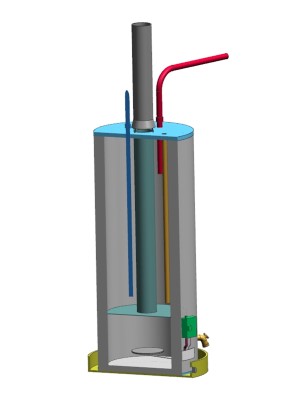- Home
- Water heater troubleshooting guide
- Fixing water heater condensation
Water Heater Condensation and How to avoid Problems due to Condensation
How to fix or reduce water heater condensation. Can it affect the water heater operation?
Is condensation considered as a leak? Find out the reasons and symptoms for worry-free heating.
One of the questions I've got from my readers is about water heater condensation. The users were mainly complaining after they've seen the puddle of water under their gas-powered heater - after coming back from a vacation, during the wintertime, or once they purchased a brand-new unit.
Symptoms
The puddle of water below the heater is the first sign of the water heater condensation or leak. You might also find black or red granules on the main gas burner when the condensate was dripping on the hot surface (you will also hear a sizzling noise). Corrosion on the jacket or around the vent is also a sign that the condensate (moisture) was present there.
Condensation - causes and potential problems
 Gas water heater
Gas water heaterWhen natural gas or propane gas is burning inside the combustion chamber of your gas heater, the flue gases are released. They contain lots of moisture, and when it is chilled below the "dew point," the condensate forms.
The "dew point" is the temperature when the water vapor turns into a liquid.
The heater usually produces one-half gallon of moisture every hour of the heater's operation, so according to the experts, condensation is a regular occurrence.
Today's heaters are producing even more condensate due to their high-efficient operation - condensation is usually noticeable when the efficiency is above 87.5%. High efficient heaters, including condensing models, utilize the heat from flue gases and transfer it to water.
As the temperature of the flue gases gets reduced, the water vapor turns into a liquid - condensate.
It is very simple to identify if there is condensation or not.
- First, if there is some water under the heater, wipe it up.
- Turn the gas control valve to the OFF position.
- Wait for several hours to see if it is wet again under the heater.
- If no water means that the heater was condensing.
- Find Plumbers In Your Area -
There are several reasons why the water heater condensation occurs:
- The flue gases are cooled below their "dew point" when having the cold air supply.
- When the water temperature inside the tank drops below 110 F. Once the water inside the tank is heated above 115 F, condensation should stop. It takes up to 2 hours for the water to heat up to the temperature where the condensation stops.
- During the cold start-up of the brand-new unit.
- An undersized gas heater.
- The temperature setting is too low.
- A large amount of hot water is used in a short time while the incoming water is very cold. Keep in mind that the cold incoming water during the wintertime and periods of cold days might produce large amounts of condensate.
If you have one of the above situations that will cause the condensation, fix the problem by increasing the temperature of the incoming air, water, or tank size. Proper, unobstructed venting is also important so the moisture can leave the heater easily.
As the condensate is mildly acidic and as it will corrode the steel vent, PVC and stainless steel vents are recommended, if applicable and required per code.
Problems associated with the water heater condensation:
- The condensate can drip onto the burner causing the pilot outage.
- Corrosion on the metal surfaces.
- Puddle of water.
Power vent and power direct vent heaters are equipped with the condensate drain, so the water vapor from the exhaust gases will roll down the PVC vent pipe and through the drain port out. The recommendation is to get a condensate drain kit for convenient draining, and metal drain pans to protect the room where the heater is installed.
Related
- Home
- Water heater troubleshooting guide
- Fixing water heater condensation
